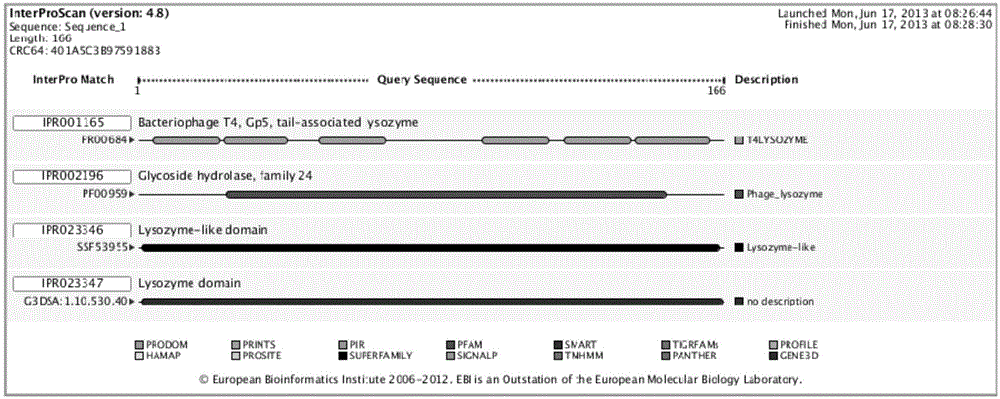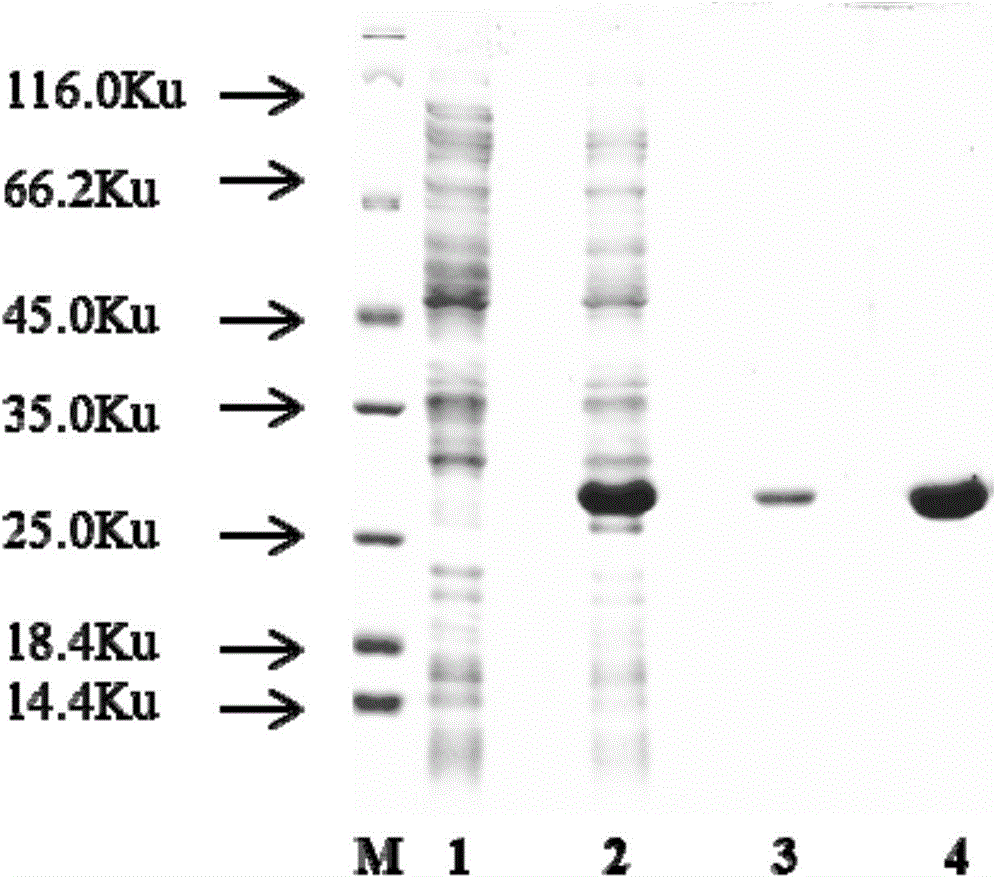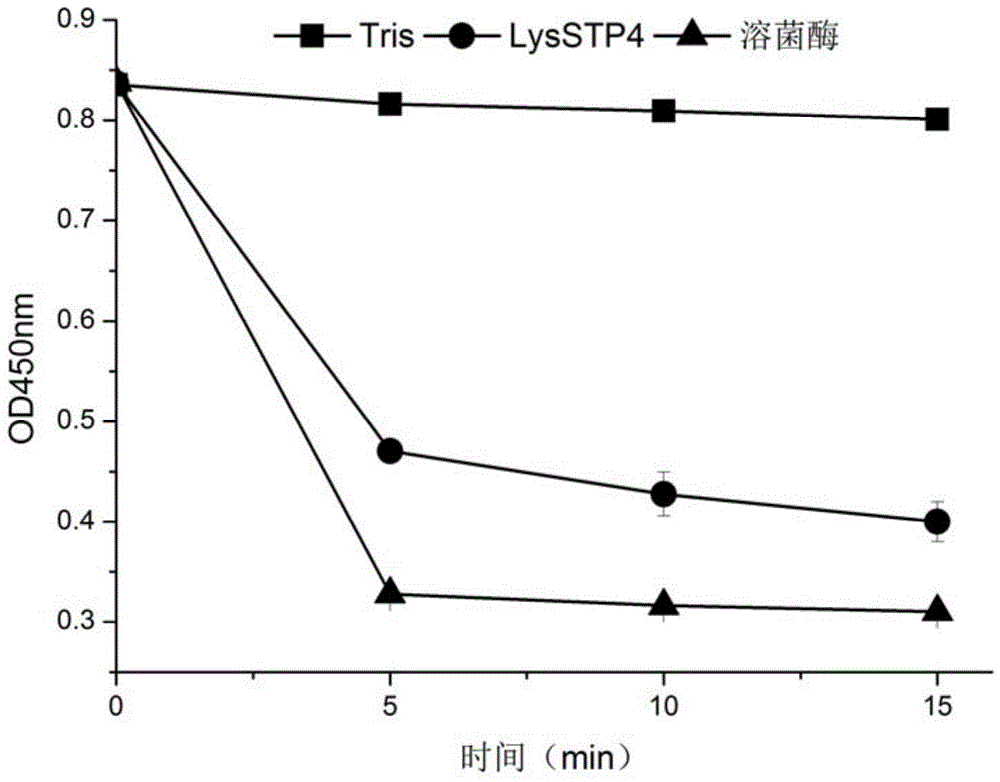Endolysin sourced from salmonella bacteriophage and application thereof
A Salmonella and endolysin technology, applied in the field of endolysin, can solve the problem of less research on the prevention and control of Gram-negative bacteria, and achieve a significant bactericidal effect
- Summary
- Abstract
- Description
- Claims
- Application Information
AI Technical Summary
Problems solved by technology
Method used
Image
Examples
Embodiment 1
[0027] Example 1: Prediction of endolysin protein function
[0028] The present inventor isolated a Salmonella virulent phage STP4-a from sewage. Through the whole genome sequencing and analysis, it is identified that the protein encoded by the phage gp193 has 65% similarity with the Escherichia coli phage T4 lysozyme in the amino acid sequence. The domain prediction analysis of gp193-encoded protein LysSTP4 was performed using InterProScan software. The domain prediction results are as follows figure 1 As shown, the 24-150 amino acid interval of LysSTP4 is a highly conserved functional region, which belongs to the Phage_lysozyme family (PF00959). This family can cleave glycosidic bonds in peptidoglycan in the cell wall of prokaryotic cells, releasing progeny phages.
Embodiment 2
[0029] Example 2: High expression of endolysin in Escherichia coli
[0030] 1. Construction of recombinant plasmids
[0031] According to the endolysin gene sequence (SEQ ID No: 2), design primers, upstream primer: CGGGATCCATGAACATTTTTGACATGCTTCG (SEQ ID No: 3), downstream primer: CCGCTCGAGTCATATGTTTTCATATGCTTTCCAA (SEQ ID No: 4), respectively set limits at the upstream and downstream primer ends Sexual endonucleases BamH Ⅰ and Xho Ⅰ. The endolysin gene was amplified by PCR, and 25 μL of the PCR recovered product was cloned into the multiple cloning site BamH I and Xho I of the pET-30a vector to obtain a recombinant plasmid, which was transformed into Escherichia coli BL21(DE3). Pick a single clone to LB liquid medium for overnight shaking culture, extract the plasmid as a template for PCR identification, the results show that the plasmid has the nucleotide sequence shown in SEQ ID No: 2, and the protein expressed by the gene is named LysSTP4, The gene encodes the amino acid...
Embodiment 3
[0034] Example 3: Taking Salmonella ATCC14028 as the target bacterium to test the antibacterial effect of endolysin LysSTP4
[0035] Pick a single colony of Salmonella ATCC14028 into 300mL nutrient broth medium, cultivate overnight, add chloroform with a final concentration of 5% to the bacterial solution, 15min, centrifuge the cells and wash them twice with pure water, then store them at -80°C, before measuring the activity , the bacterial pellet was reconstituted with 50mmol / L Tris-HCl pH8.2 containing 0.1% Triton X-100. Add 100 μL of recombinant protein LysSTP4 solution (100 μg / mL) to 900 μL of bacterial reconstitution solution, and incubate at 37°C until the lysis effect is obvious. Tris buffer and lysozyme (100 μg / mL) were used as the blank group and the positive control group were mixed with the bacterial reconstitution solution, cultivated under the same conditions, and the OD450 value was measured with a microplate reader. The decrease in the absorbance value reflected...
PUM
 Login to View More
Login to View More Abstract
Description
Claims
Application Information
 Login to View More
Login to View More - R&D
- Intellectual Property
- Life Sciences
- Materials
- Tech Scout
- Unparalleled Data Quality
- Higher Quality Content
- 60% Fewer Hallucinations
Browse by: Latest US Patents, China's latest patents, Technical Efficacy Thesaurus, Application Domain, Technology Topic, Popular Technical Reports.
© 2025 PatSnap. All rights reserved.Legal|Privacy policy|Modern Slavery Act Transparency Statement|Sitemap|About US| Contact US: help@patsnap.com



